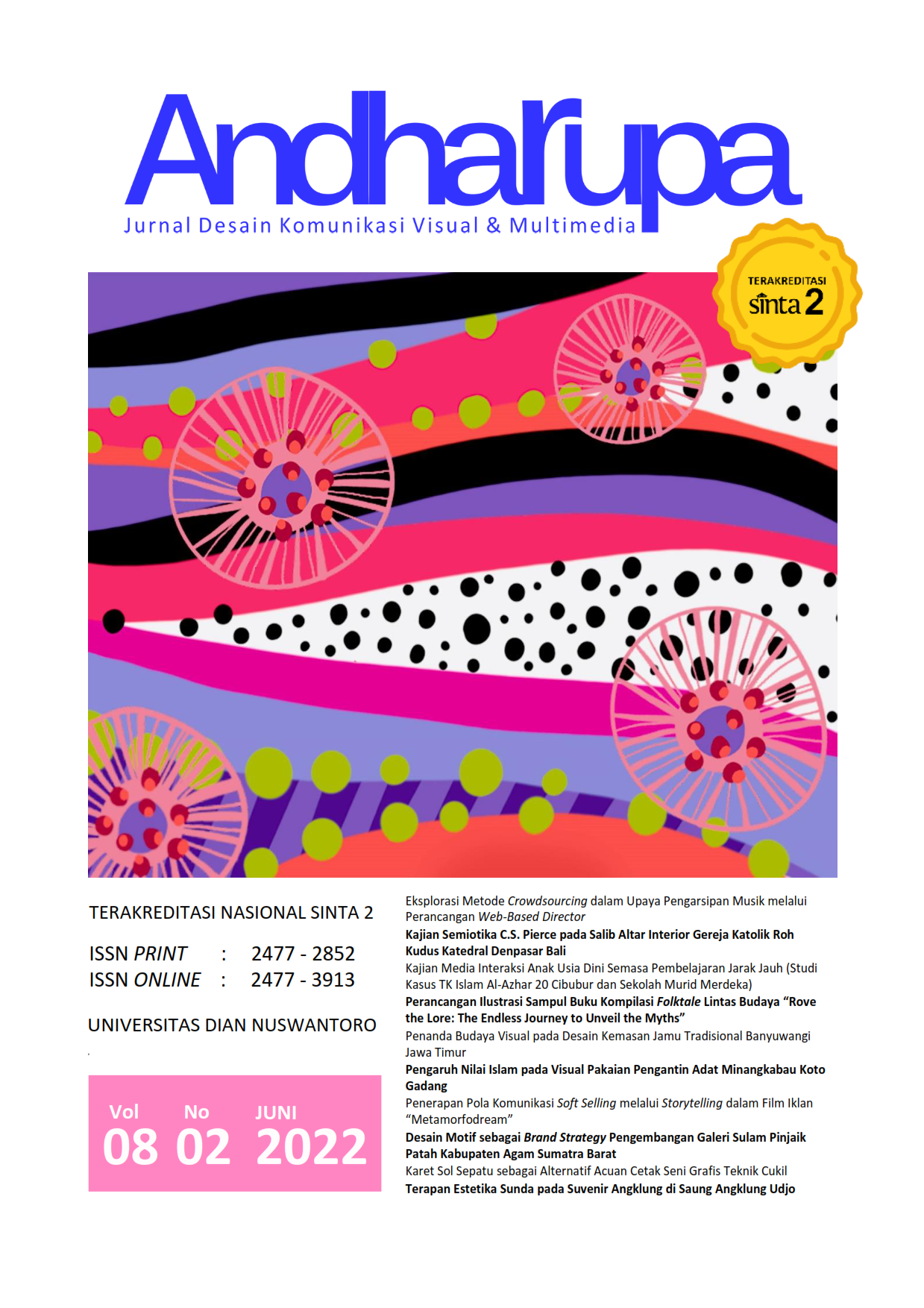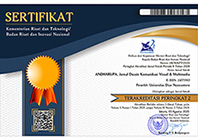Eksplorasi Metode Crowdsourcing dalam Upaya Pengarsipan Musik melalui Perancangan Web-Based Director
DOI:
https://doi.org/10.33633/andharupa.v8i02.4398Abstract
Abstrak Penelitian ini dilakukan untuk mengkaji dan mengeksplorasi metode crowdsourcing (urun daya) sebagai pendekatan alternatif yang dapat diterapkan dalam merancang sebuah platform pengarsipan digital. Dalam sebuah upaya pengumpulan data dan informasi, karakteristik metode ini umumnya dimanfaatkan melalui platform digital agar mendapatkan lebih banyak informasi, ide hingga solusi secara cepat dengan melibatkan banyak pihak dalam jaringan internet. Sehubungan dengan hal tersebut, metode crowdsourcing dapat dihadirkan sebagai tawaran alternatif dalam mengakomodasi kebutuhan pengarsipan musik di Indonesia, berdasarkan fenomena, kondisi dan permasalahan pengarsipan musik yang dapat teridentifikasi. Untuk menghasilkan rekomendasi yang relevan, tiga studi terdahulu tentang crowdsouricng dipilih berdasarkan korelasinya dengan teknis pengumpulan data secara crowdsourcing (Crowdsourced data gathering). Literatur tersebut dikaji agar dapat menghasilkan rekomendasi alur penerapan, rancangan, serta mendefinisikan spesifikasi fitur-fitur antarmuka yang tepat dan efisien dalam langkah implementasi metode crowdsourcing kedalam sebuah desain media informasi digital. Melalui penelitian ini, tinjauan implementasi metode crowdsourcing pada platform pengarsipan diharapkan dapat menjadi tawaran alternatif dalam meningkatkan efisiensi jalannya upaya pengarsipan musik dan meminimalisir permasalahannya yang terjadi di Indonesia. Kata kunci: crowdsourcing, direktori, musik, pengarsipan AbstractThis research was aim to study and explore the crowdsourcing method as an alternative approach that can be applied to designing a digital archiving platform. In an archiving and information gathering initiative, the characteristics of this method are generally utilized through digital platforms in order to get more information, ideas and solutions quickly by involving many parties in the internet network. In this regard, the crowdsourcing method can be presented as an alternative implementation in accommodating the needs of musical archiving in Indonesia, based on the emerging phenomena, conditions and problems. To produce relevant recommendations, previous studies on crowdsourcing method were selected based on their correlation with the crowd-sourced data gathering technique. The literature is reviewed in order to produce recommendations for the implementation flow, design, and define the appropriate and efficient specification of interface features in the implementation phase of the crowdsourcing method to form an efficient design for digital information media. Through this study, a review of the implementation of the crowdsourcing method on archiving platforms is expected to be an alternative offer in increasing the efficiency of music archiving efforts and minimizing the problems that occur in Indonesia. Keywords: archiving, crowdsourcing, directory, musicReferences
Çano, Erion. (2017). Crowdsourcing Emotions in Music Domain. International Journal of Artificial Intelligence & Applications. 8. 25-40.
Flew, Terry. (2005): Creative Commons and the Creative Industries, QUT Digital Repository, Australia.
Gomes, C., Schneider, D., Moraes, K., & de Souza, J. (2012). Crowdsourcing for music: Survey and taxonomy. 2012 IEEE International Conference on Systems, Man, and Cybernetics (SMC).
Hartnett, J. (2015) Discogs.com. The Charleston Advisor. 16(4).
Hemerly, Jess. (2011). Making Metadata: The Case of MusicBrainz. SSRN Electronic Journal. 10.2139/ssrn.1982823.
Hosseini, Mahmood & Shahri, Alimohammad & Phalp, Keith & Taylor, Jacqui & Ali, Raian. (2015). Crowdsourcing: A taxonomy and systematic mapping study. Computer Science Review. 17.
Ibrahim, Raka. (2016). Jalan Terjal Pengarsipan Musik Indonesia. Jurnal Ruang
Irsal, Irfan Aulia. (2018). 95 Persen Metadata Musik Indonesia di YouTube Tak Terkumpul. https://www.cnnindonesia.com/hiburan/20181114184525-227-346615/95-persen-metadata-musik-indonesia-di-youtube-tak-terkumpul. Diakses 27 September 2020.
Jesse James Garrett. (2011). The Elements of User Experience. Berkeley California
KAMI. (2018). Laporan Bincang Musik - Pusat Data dan Pengarsipan Musik
Kemenparekraf. (2014). Ekonomi Kreatif: Rencana Pengembangan Industri Musik nasional 2015-2019. PT. Republik Solusi, Jakarta.
Kittur, Aniket & Kraut, Robert. (2008). Harnessing the wisdom of crowds in Wikipedia: Quality through coordination. Proceedings of the ACM Conference on Computer Supported Cooperative Work, CSCW.
Nakatsu, Robbie & Iacovou, Charalambos. (2014a). An Investigation of User Interface Features of Crowdsourcing Applications.
Nakatsu, Robbie & Grossman, Elissa & Iacovou, Charalambos. (2014b). A Taxonomy of Crowdsourcing Based on Task Complexity. Journal of Information Science.
Nandan, Naveen & Pursche, Andreas & Zhe, Xing. (2014). Challenges in Crowdsourcing Real-Time Information for Public Transportation. Proceedings - IEEE International Conference on Mobile Data Management. 2. 67-72.
Nielsen, J. (1994a). Enhancing the explanatory power of usability heuristics. Proc. ACM CHI'94 Conf. Boston.
Niu, Xiao-Jing & Qin, Sheng-feng & Vines, John & Wong, Rose & Lu, Hui. (2018). Key Crowdsourcing Technologies for Product Design and Development. International Journal of Automation and Computing. 16.
Osterloh, M. & Rota, S. (2004) Trust and community in open source software production. Analyse & Kritik, Vol 26, Issue 1.
Resmadi, Idhar. (2019). “Inisiatif Pengarsipan Musik Lokal”. Hasil Wawancara Pribadi: 23 November 2019, Konferensi Musik Indonesia (KAMI) 2019, Sabibulungan, Kabupaten Bandung.
Resmadi, Idhar., Bastari, R.P. (2020). RANGKUMAN RISET Pemetaan Ekologi Sektor Musik Indonesia. British Council, Indonesia.
Simula, H. and Ahola, T. (2014) “A network perspective on idea and innovation crowdsourcing in industrial firms”, Industrial Marketing Management, Vol. 43, No. 3, pp.
Sicilia, M. (2020). Knowledge Coproduction in Discogs Music Database: A study of the motivations behind a crowdsourced online discography (Dissertation).
Tattersall, A., (2017) Disentangling the academic web: what might have been learnt from Discogs and IMDB [Blog] LSE Impact Blog. Available at: https://blogs.lse.ac.uk/impactofsocialsciences/2017/02/01/disentangling-the-academic-web-what-might-have-been-learnt-from-discogs-and-imdb/
Zakaria, F. Malawi, D.P., Qotrunadha S. Lokananta, Perum. Percetakan Negara Republik Indonesia, Surakarta.
Downloads
Published
Issue
Section
License
Authors who publish with this journal agree to the following terms:
- Authors retain copyright and grant the journal right of first publication with the work simultaneously licensed under a Creative Commons Attribution License that allows others to share the work with an acknowledgment of the work's authorship and initial publication in this journal.
- Authors are able to enter into separate, additional contractual arrangements for the non-exclusive distribution of the journal's published version of the work (e.g., post it to an institutional repository or publish it in a book), with an acknowledgment of its initial publication in this journal.
- Authors are permitted and encouraged to post their work online (e.g., in institutional repositories or on their website) prior to and during the submission process, as it can lead to productive exchanges, as well as earlier and greater citation of published work (See The Effect of Open Access).















